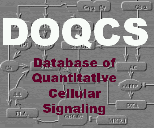| |
Reaction
Name | Pathway Name /
Pathway No. | Kf | Kb | Kd | tau | Reagents |
| 1 | turnover | Shared_Object_
AMPAR_CaMKII_
strong_coupling
Pathway No. 271 | 0.018
(s^-1) | 1
(s^-1) | Not applicable** | - | Substrate:
AMPAR_bulk
Products:
A_B
|
| Represents both synthesis and degradation of the receptor. The rate is set to be rather fast for now. The forward rate also includes scaling terms because the AMPAR_bulk is in the dendritic volume of 5e-18. This means that we need to lower Kf to account for the difference in volumes. Effectively Kf is 1/sec, but the scaled version becomes 9e-20/5e-18 = 0.018 | | 2 | transloc_2 | Shared_Object_
AMPAR_CaMKII_
strong_coupling
Pathway No. 271 | 0
(#^-1 s^-1) | 0
(s^-1) | Not applicable** | - | Substrate:
CaMKII-thr286*-C
aM
NMDAR
Products:
CaMKII-thr286-Ca
M-PSD
|
| Same as for transloc_1 | | 3 | transloc_1 | Shared_Object_
AMPAR_CaMKII_
strong_coupling
Pathway No. 271 | 0
(#^-1 s^-1) | 0
(s^-1) | Not applicable** | - | Substrate:
CaMKII-CaM
NMDAR
Products:
CaMKII-CaM-PSD
|
| Rates to match curve in fig2 from Shen and Meyer, Science 284:162-166(1999), calculated for 6:1 alpha:beta CaMKII heterodimers | | 4 | Stoch_Basal_
CaMKII_PSD | Shared_Object_
AMPAR_CaMKII_
strong_coupling
Pathway No. 271 | 1
(s^-1) | 1
(s^-1) | Keq = 1(uM) | 0.5sec | Substrate:
basal_CaMKII_
PSD_control
Products:
basal_CaMKII_
PSD
|
| 5 | Release-C2 | PKA
Pathway No. 277 | 60
(s^-1) | 17.9998
(uM^-1 s^-1) | Kd(cb) = 0.3(uM) | - | Substrate:
R2C-cAMP4
Products:
PKA-active
R2-cAMP4
|
| 6 | Release-C1 | PKA
Pathway No. 277 | 60
(s^-1) | 17.9998
(uM^-1 s^-1) | Kd(cb) = 0.3(uM) | - | Substrate:
R2C2-cAMP4
Products:
PKA-active
R2C-cAMP4
|
| This has to be fast, as the activation of PKA by cAMP is also fast. kf was 10 | | 7 | recycle__ | AMPAR
Pathway No. 280 | 0.0008
(s^-1) | 0
(#^-1 s^-1) | Not applicable** | - | Substrate:
A_B
Products:
A_B
Anchor
|
| 8 | recycle_* | AMPAR
Pathway No. 280 | 0.0008
(s^-1) | 0
(#^-1 s^-1) | Not applicable** | - | Substrate:
A_B831*
Products:
A_B831*
Anchor
|
| 9 | recycle*_ | AMPAR
Pathway No. 280 | 0.0008
(s^-1) | 0
(#^-1 s^-1) | Not applicable** | - | Substrate:
A831*_B
Products:
A831*_B
Anchor
|
| 10 | recycle** | AMPAR
Pathway No. 280 | 0.0008
(s^-1) | 0
(#^-1 s^-1) | Not applicable** | - | Substrate:
A831*_B831*
Products:
A831*_B831*
Anchor
|
| 11 | PKC-stoch-input | Shared_Object_
AMPAR_CaMKII_
strong_coupling
Pathway No. 271 | 2.5
(s^-1) | 2.5
(s^-1) | Keq = 1(uM) | 0.2sec | Substrate:
PKC-control
Products:
PKC-active
|
| 12 |
neurogranin-bind
-CaM_
PSD | CaM
Pathway No. 273 | 0.3
(uM^-1 s^-1) | 1
(s^-1) | Kd(bf) = 3.3333(uM) | - | Substrate:
neurogranin_PSD
CaM-PSD
Products:
neurogranin-CaM_
PSD
|
| Surprisingly, no direct info on rates from neurogranin at this time. These rates are based on GAP-43 binding studies. As GAP-43 and neurogranin share near identity in the CaM/PKC binding regions, and also similarity in phosph and dephosph rates, I am borrowing GAP-43 kinetic info. See Alexander et al JBC 262:13 6108-6113 1987 | | 13 | neurogranin-bind
-CaM | CaM
Pathway No. 273 | 0.3
(uM^-1 s^-1) | 1
(s^-1) | Kd(bf) = 3.3333(uM) | - | Substrate:
neurogranin
CaM
Products:
neurogranin-CaM
|
| Surprisingly, no direct info on rates from neurogranin at this time. These rates are based on GAP-43 binding studies. As GAP-43 and neurogranin share near identity in the CaM/PKC binding regions, and also similarity in phosph and dephosph rates, I am borrowing GAP-43 kinetic info. See Alexander et al JBC 262:13 6108-6113 1987 | | 14 | inhib-PKA | PKA
Pathway No. 277 | 59.9994
(uM^-1 s^-1) | 1
(s^-1) | Kd(bf) = 0.0167(uM) | - | Substrate:
PKA-active
PKA-inhibitor
Products:
inhibited-PKA
|
| This has to be set to zero for matching the expts in vitro. In vivo we need to consider the inhibition though. kf = 1e-5 kb = 1 | | 15 | Inact-PP1 | PP1
Pathway No. 274 | 499.981
(uM^-1 s^-1) | 0.1
(s^-1) | Kd(bf) = 0.0002(uM) | - | Substrate:
I1*
PP1-active
Products:
PP1-I1*
|
| K inhib = 1nM from Cohen Ann Rev Bioch 1989, 4 nM from Foukes et al Assume 2 nM. kf /kb = 8.333e-4 | | 16 | Inact-PP1 | Shared_Object_
AMPAR_CaMKII_
strong_coupling
Pathway No. 271 | 499.98
(uM^-1 s^-1) | 0.1
(s^-1) | Kd(bf) = 0.0002(uM) | - | Substrate:
I1*
PP1-active_PSD
Products:
PP1-I1*
|
| K inhib = 1nM from Cohen Ann Rev Bioch 1989, 4 nM from Foukes et al Assume 2 nM. kf /kb = 8.333e-4 | | 17 | exo_reg__ | AMPAR
Pathway No. 280 | 0.0002
(#^-1 s^-1) | 0.008
(s^-1) | Not applicable** | - | Substrate:
A845*_B845*
Anchor
Products:
A845*_B845*
|
| Exo rates are scaled from earlier model versions to account for binding of anchor. We have about 200 molecules of anchor in the whole model. Here we select rates to give us a max of about 150 molecules of GluR at the synapse. | | 18 | exo_reg_* | AMPAR
Pathway No. 280 | 0.0002
(#^-1 s^-1) | 0.008
(s^-1) | Not applicable** | - | Substrate:
A845*_B831*845*
Anchor
Products:
A845*_B831*845*
|
| 19 | exo_reg*_ | AMPAR
Pathway No. 280 | 0.0002
(#^-1 s^-1) | 0.008
(s^-1) | Not applicable** | - | Substrate:
A831*845*_B845*
Anchor
Products:
A831*845*_B845*
|
| 20 | exo_reg** | AMPAR
Pathway No. 280 | 0.0002
(#^-1 s^-1) | 0.008
(s^-1) | Not applicable** | - | Substrate:
A835*845*_
B835*845*
Anchor
Products:
A835*845*_
B835*845*
|
** This is a trasport reation between compartments of different volumes. Therefore Kd is not applicable. Please Note Kf, Kb units are in number of molecules instead of concentration